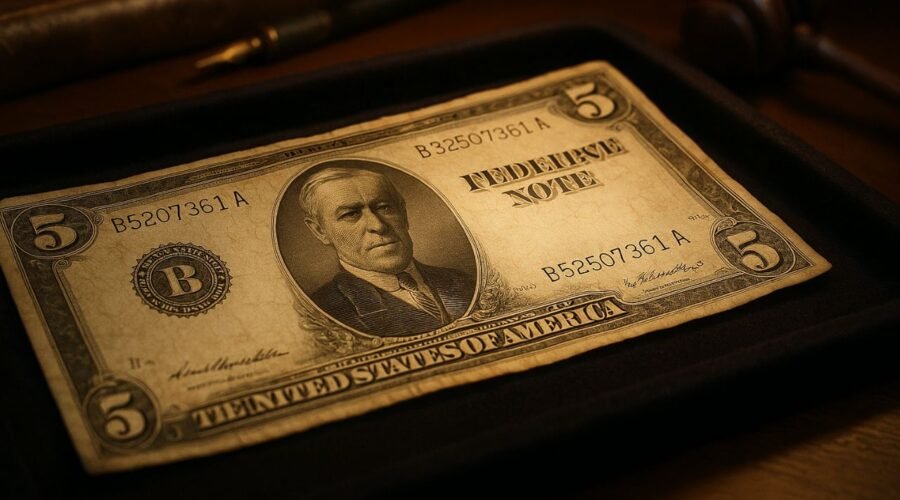The 1918 Federal Reserve Note- A Rare Piece Of U.S. Currency With A Unique History
The 1918 Federal Reserve Note is a significant artifact in the history of U.S. currency. Issued during a transformative period, these notes are not only rare but also rich in historical significance.
This article delves into the details, features, and value of the 1918 Federal Reserve Note, shedding light on why it remains a prized possession for collectors and historians alike.
In 1918, the U.S. Treasury introduced a new series of Federal Reserve Notes, marking a significant evolution in American currency. Th
ese notes were part of the government’s efforts to modernize and standardize the nation’s monetary system.
Key Features of the 1918 Federal Reserve Note
Denominations and Design
The 1918 series included denominations of $500, $1,000, $5,000, and $10,000. Each note featured distinct designs:
- $500 Note: Featured a portrait of Abraham Lincoln.
- $1,000 Note: Displayed Grover Cleveland.
- $5,000 Note: Featured James Madison.
- $10,000 Note: Showcased Salmon P. Chase.
These notes were larger in size compared to modern currency, often referred to as “horse blanket” notes due to their dimensions.
Security Features
The 1918 notes incorporated advanced security features for their time, including:
- Red and blue fibers embedded in the paper.
- Watermarks for authenticity.
- Intricate engravings to deter counterfeiting.
Historical Context and Issuance
The issuance of the 1918 Federal Reserve Notes coincided with significant events in U.S. history:
- World War I: The U.S. government’s need for funds to support the war effort led to the introduction of these high-denomination notes.
- Pittman Act of 1918: This act authorized the Treasury to issue these notes as a means to replace silver certificates that were being withdrawn from circulation.
The notes were issued by the Federal Reserve Banks and were backed by the U.S. government, ensuring their acceptance for all debts, public and private.
Rarity And Collectibility
The 1918 Federal Reserve Notes are among the rarest U.S. currency notes. Several factors contribute to their scarcity:
- Limited Printing: Only a small number of these high-denomination notes were printed.
- Survival Rate: Many were withdrawn from circulation and destroyed, leaving few in existence today.
- Collector Demand: Their historical significance and rarity make them highly sought after by collectors.
For instance, the 1918 $1,000 note had a combined total of 316,400 notes printed across all districts, with few surviving today.
In contrast, the Bureau of Engraving and Printing now prints nearly 20 million bank notes per day, highlighting the rarity of these 1918 notes.
Value And Market Trends
The value of a 1918 Federal Reserve Note varies based on several factors:
- Denomination: Higher denominations generally command higher prices.
- Condition: Notes in better condition (graded by organizations like PMG or PCGS) are more valuable.
- Rarity: Notes from less common districts or with unique serial numbers can fetch premium prices.
For example, a 1918 $1,000 Federal Reserve Note in good condition can be valued at over $250,000, reflecting its rarity and demand among collectors.
Preservation and Authentication
Given their age and value, proper preservation and authentication are crucial for owners of 1918 Federal Reserve Notes:
- Storage: Notes should be kept in protective sleeves or holders to prevent physical damage.
- Grading: Professional grading services assess the condition and authenticity of the notes, which can significantly affect their market value.
- Authentication: Certificates of authenticity from reputable sources add credibility and value to the notes.
Overview of 1918 Federal Reserve Notes
| Denomination | Portrait Featured | Estimated Survival Rate | Approximate Value (Good Condition) |
|---|---|---|---|
| $500 | Abraham Lincoln | Very Low | $50,000+ |
| $1,000 | Grover Cleveland | Extremely Low | $250,000+ |
| $5,000 | James Madison | Low | $500,000+ |
| $10,000 | Salmon P. Chase | Very Low | $1,000,000+ |
The 1918 Federal Reserve Note is more than just a piece of currency; it’s a testament to a pivotal era in U.S. history.
Its rarity, distinctive features, and historical context make it a prized possession for collectors and a fascinating subject for historians.
Whether you’re a seasoned numismatist or a history enthusiast, understanding the significance of these notes offers a deeper appreciation for the evolution of American currency.
Frequently Asked Questions
Why are 1918 Federal Reserve Notes so rare?
Their rarity stems from limited printing, high denominations that were seldom used, and many notes being withdrawn and destroyed over time.
How can I determine the value of my 1918 Federal Reserve Note?
The value depends on factors like denomination, condition, and rarity. Professional grading and authentication can provide an accurate assessment.
Are there any 1918 Federal Reserve Notes still in circulation?
No, these notes were withdrawn from circulation decades ago and are now primarily found in private collections or museums.


Leave a Reply